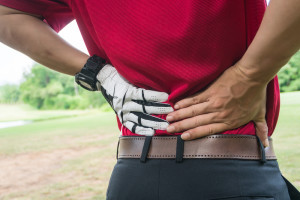 November and December have been great months for golfers in Australia with the Australian Open and then the World Cup of Golf being held in Melbourne. Also, congratulations to Curtis Luck, WA’s Sports Star of the Year.
November and December have been great months for golfers in Australia with the Australian Open and then the World Cup of Golf being held in Melbourne. Also, congratulations to Curtis Luck, WA’s Sports Star of the Year.
Following on from our article on shoulder function and how it can affect your swing, to help you lift your game to the next level we’re going to take a closer look at your low back and how it could be holding you back from a better handicap.
The Lower Back
From a practitioner’s point of view, the low back comprises the pelvic bones and the sacrum and lumbar spine (the two lower sections of the spinal column). However through some of its muscle connections it has wide reaching impact. For example, the latissimus dorsi which connects the lower back to the shoulder, and the hamstrings, which connect the pelvis to the knee.
The Pelvic Muscles
The low back is a very complex structure from a neuro-muscular point of view. In the back of the pelvis there are the gluteal muscles which are responsible for extending the hip (gluteus medius and maximus) and moving it out sideways (gluteus medius and minimus, and the TFL). Around the front you have the iliacus and psoas muscles, which flex the hip up and/or flex the spine forward. Moving the hip inward there are the adductor muscles on the inside of your thigh.
Lumbar Spine Muscles
In the lumbar spine you have two layers or groups of muscles at the back. There are big muscles called the erector spinae and the quadratus lumborum, which bend the spine laterally (sideways) or extend it backward. These muscles extend across the whole of the lumbar spine and up into the midback of the thoracic spine.
Deeper in there are small muscles that cross just 1-3 spinal vertebrae. They may be just 2-3 cm long. These include the multifidi, rotatores and intertransversarii. They are responsible for moving the individual vertebrae, and contain large numbers of sensory organs called muscle spindles, which transmit position information about the muscles and joints to the brain.
In fact some research has suggested that the major function of these small spinal muscles is more about helping the brain sensing the position of the spine than actually moving the spine itself. This information is very important as it helps the brain know when joints and muscles are functioning within their normal range of movement at any given moment and vital for neuromuscular recruitment and coordination elsewhere. When this breaks down, injury is more likely to occur.
Around the front of the lumbar spine there are the psoas muscles mentioned earlier. These are located right in front of the spine. In the front of the organs of the abdomen there are the abdominal muscles. The vertically orientated abdominal muscles, the rectus abdominus, are the muscles people work to develop the famous six-pack abs. However in addition there are the functionally important oblique muscles that help the spine twist, and the horizontal transversus abdominus, which is important for spinal stability.
The Core Muscles
There is this concept of the “core”, which is important for stability of the spine. If your low back is functioning well, whenever you load the spine (e.g. lifting something), your deep smaller lumbar spine muscles, the one’s targeted with Pulstar Spine Scan, will contract along with your transversus abdominus to brace the spine and stabilise it.
If that fails your spine is predisposed to injury, and you won’t develop the strength you otherwise could. This might show up with your drives stopping short.
Specific Muscle Actions During Your Swing
Just as the shoulder muscles can compromise your swing, weak or tight low back muscles can prevent you from finding “the slot” and send the ball flying wide.
Backswing:
As you come back into the backswing tightness or weakness in the oblique abdominals, erector spinae and quadratus lumborum will restrict this movement. It is interesting to note that 33% of people with low back pain will have weak quadratus an/ or oblique abdominal muscles. If you have a history of back pain, there’s a good chance these muscles will be weak on you. They can be brought back “on-line” quickly and easily with the use of your built in reflexes, Trigenics and Pulstar Spine Scan.
Forward Swing and Acceleration:
As you start the downswing, those same muscles will be activated to generate the power of the swing. Obviously, if they are weak or if your core muscles are not neurologically activated or coordinated correctly, you won’t be developing the power that you are capable of.
Additionally, you may be recruiting other muscles to compensate for the weakness in these main muscles. This will cause different movement patterns, pulling your swing off line and increasing the chances of injury.
Your hip adductors will prevent abnormal sideways movements of your pelvis as you swing. If they fail to do this, you increase the chances of slicing the ball.
Follow Through
Similar to the backswing, the same muscles will be stretched, just in the opposite direction. Asymmetry of function ( weakness or tightness ) can result in either a problem during the backswing or follow through depending on the asymmetry.
Correcting Low Back Function
If you suffer from low back pain, you’re probably already aware of the need to improve your back’s function. However if you don’t have back pain, you may not be aware of the negative impact it is having on your golf.
Perth Chiropractor, Dr Adam Rocchi, uses a treatment system known as Trigenics to assess muscle function throughout the body. Trigenics focuses on the length and strength of the muscles.
When abnormal neurology in the form of weak or shortened muscles are found, Dr Rocchi ( chiropractor) uses brain and spinal cord reflexes to restore normal muscle length and strength. He also uses a computerised tool known as the Pulstar , which aims to identify any restriction in the movement of the individual spinal segments and delivers carefully controlled, mechanical impulses at specific predetermined force into those vital multifidus muscles that surround the vertebrae to help restore normal movement.
If you know your low back’s holding you back call (08) 61508783 to arrange an appointment.


No comments yet.